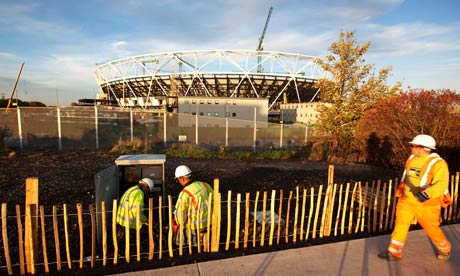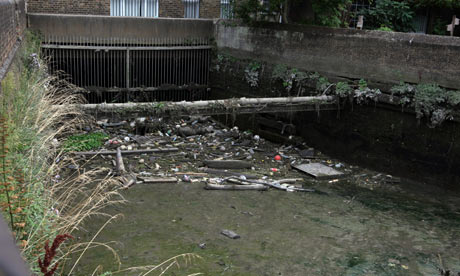Cleaning the environmental and social conditions of the 2012 Olympic Park
 The clock is counting down to the start of the 2012 Olympics in London. The main Olympic Park [map] is located in East London in heart of the Lower Lea Valley, which happens to be the same place I studied in my recently completed PhD. My research demonstrated the close correlation between the degraded environmental conditions and the disadvantaged social conditions in the sections of West Ham built on the wetlands. I ended my dissertation wondering whether the current multi-billion dollar project to clean up the environment for the Olympics might result in a comparable effort to clean out the socially undesirable people from this landscape.
The clock is counting down to the start of the 2012 Olympics in London. The main Olympic Park [map] is located in East London in heart of the Lower Lea Valley, which happens to be the same place I studied in my recently completed PhD. My research demonstrated the close correlation between the degraded environmental conditions and the disadvantaged social conditions in the sections of West Ham built on the wetlands. I ended my dissertation wondering whether the current multi-billion dollar project to clean up the environment for the Olympics might result in a comparable effort to clean out the socially undesirable people from this landscape.
An article in the Guardian, “Houseboaters being ‘socially cleansed’ from Olympics area,” suggests this process might be underway. House boaters are concerned that British Waterways are going to increase the mooring costs along canals in the Lower Lea:
British Waterways, which manages 2,200 miles of canals and rivers, has put forward changes to the mooring rules on the river Lea, in east London, that could increase the cost of living on the waterway from about £600 to £7,000 a year. Residents see the move as a deliberate attempt to drive them away. A draft note from British Waterways on 6 December 2010, seen by the Guardian, says: “The urgency … relates to the objective of reducing unauthorized mooring on the Lea navigation and adjacent waterways in time for the Olympics.”
 Former industrial sites worldwide are constantly reinvented and redeveloped reflecting changes in economies and societies over time. Nowhere else in Europe is regeneration of a former industrial site more spectacular than the 2012 Olympic site on the banks of the River Lea in West Ham, East London. The creation of the Olympic park promises the rehabilitation of the Lower Lea Valley by restoring its eco-system and revitalising the community of the area.
Former industrial sites worldwide are constantly reinvented and redeveloped reflecting changes in economies and societies over time. Nowhere else in Europe is regeneration of a former industrial site more spectacular than the 2012 Olympic site on the banks of the River Lea in West Ham, East London. The creation of the Olympic park promises the rehabilitation of the Lower Lea Valley by restoring its eco-system and revitalising the community of the area.
